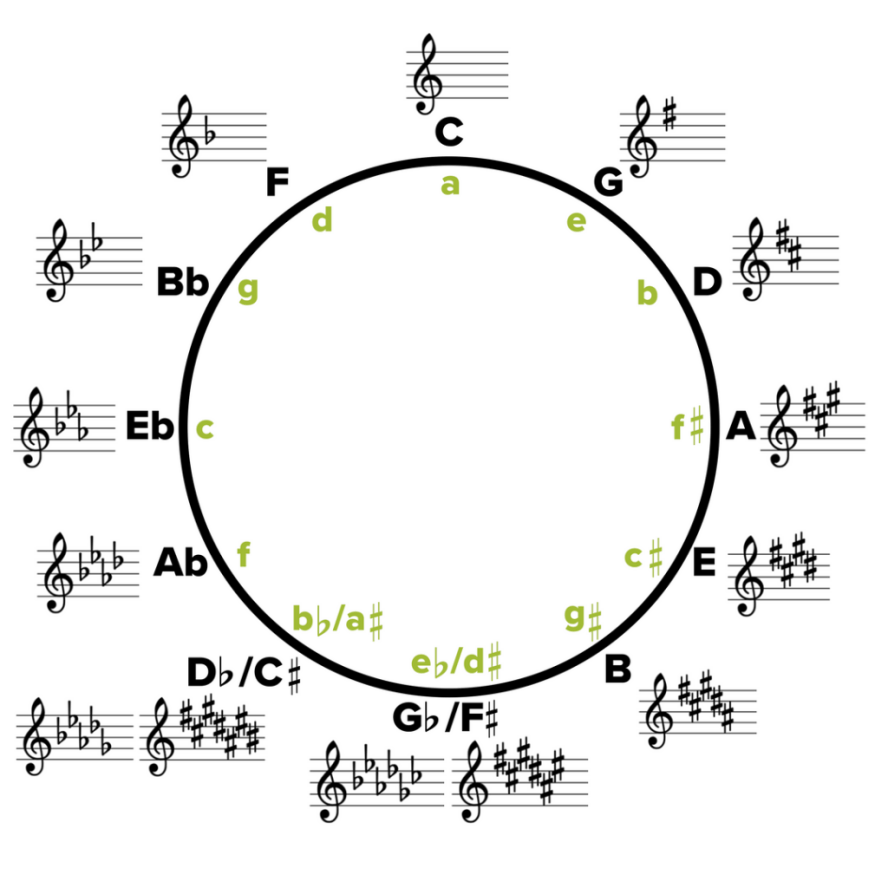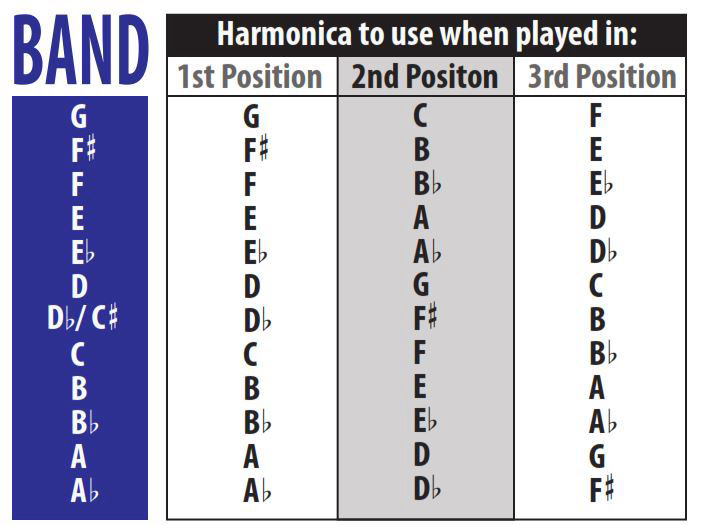Do you want to know the key to play harmonica in various positions? How to pick the right harp key for a particular tune? Looking for an answer to these questions for yourself: "why use one position and why not try another?" This lesson answers all such queries.
One of the most important topics that are addressed in connection with the study of harmonica is 'positions'. You may happen to read that someone plays in second position or hear somebody proclaiming to be playing in the third position, and another player shares that he uses the first position. What positions do they talk about, what does it mean at all? The definition is something that emanates from an image representing 'circle of fifths'.

This picture is a representation of twelve keys in which we can play; i.e. starting from the top we have C, and then moving clockwise we find G, then D and so on. What does the term 'playing in second position' signify? Simply take key of the song and one from the harmonica and count them to figure out number of positions that lie between the key of harmonica and that of the song itself. For example: if the track is in D and we use a C harmonica, we count C, G, D to conclude that we are playing in third position. Note that both of the positions - the one occupied by the harmonica key and the final position of the piece - are also included in this count.
Let's take another example: a B flat harps, playing on an F song. We count clockwise and we have B flat and F which reflects that we are working in second position.
Yet one more example: let's take a C harp and play on an E song; it will be in fifth position and the keys in focus here are C, G, D, A and E.
Speaking in context of positions, there is one more important aspect that shouldn't be neglected which is about the song modes; i.e. major or minor. Often, we come across certain examples on playing harmonica that one played in third position on a minor song, in first position on a major one or still in second position on a blues track. This means that some positions are more comfortable to play on minor songs and others on majors, whereas some are best suited to blues while others to jazz.
The decision, which of these positions to opt for, depends mainly on the notes that the harmonica provides us and afterwards on how funtional its execution is. This is the first variable that counts while making the choice for the harmonica, but there are more such as the sound properties of the harmonica. An F harmonica conveys different sensations to its listener than a G harp when compared; the former produces much more acute notes.
How do you choose the harmonica to play in a given position? In addition to the circle of fifht, we can count on the table given below:

These tables, formed for all kinds, show which harmonica to pick to play in a given position depending on the key in which the band is playing.
Another easy way to select the harmonica, using the chromatic scale, is this:
To play in first position: take a harmonica in the same key of the song.
Take 7 half-tones down to play in the second position; e.g. G song going down the musical scale we have F, E, D, C.
For the third position, take one whole tone down; for example: D track, C harp.
To play in fourth position, take the 3-half-tones up. For example; if the track is in A, take the C harmonica.
To play in fifth position, take the 2 whole tone down. For example; E song, you take the C harp.
How do you play in different positions?
Even more important than knowing how to choose the harmonica in the correct key, to play in a given position on a piece, is knowing which notes to play and which to avoid. To achieve this goal, there are two ways: try using the ear or know some important notions of musical theory. We're basically talking about musical intervals and scales. In fact, playing in a given position is nothing more than referring to one or more musical scales. Do you want an example? When playing in third position on a minor track, we use the D minor scale called 'Dorian' as well as the D blues Scale. This scales provides a minor third (natural F) and also the minor seventh (natural C).
Harmonica players who also play other musical instruments or have studied musical theory, reason in terms of musical scales and know exactly where each one of these notes can be found on a harmonica. The association note, interval and position of the holes becomes automatic when the musician really gets hold of the instrument.
If you want to comment this lesson use the contact form available here.
Eddie Marton
I just bought my first harmonica. I want this so much. I want it for myself. I tried playing the guitar for 5 years. I'm not giving up on making music. Just trying a different approach, thank you for this lesson!
Leo Gregory
Been playing harmonica since 2 months, always have played by ear. These explainations about positions sound easy enough, I'm giving them a try!. Thanks for sharing.
Tobias Blaga
So glad I found your website! I've been wanting to learn to play for a long time, but really never got into it like I wanted. Going to go full speed with it now that I found your lessons! Thank you!